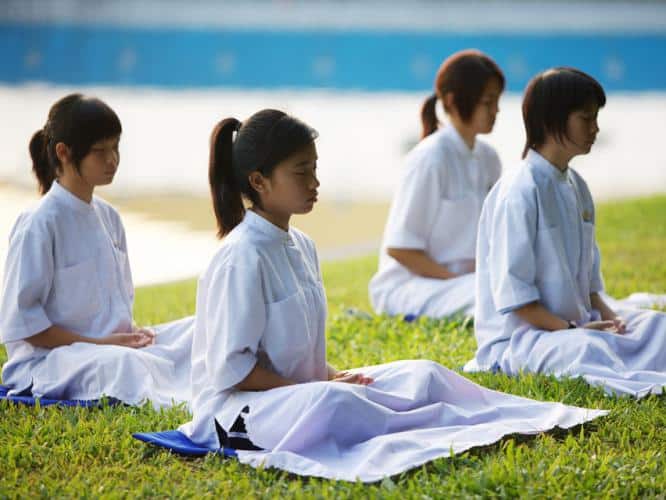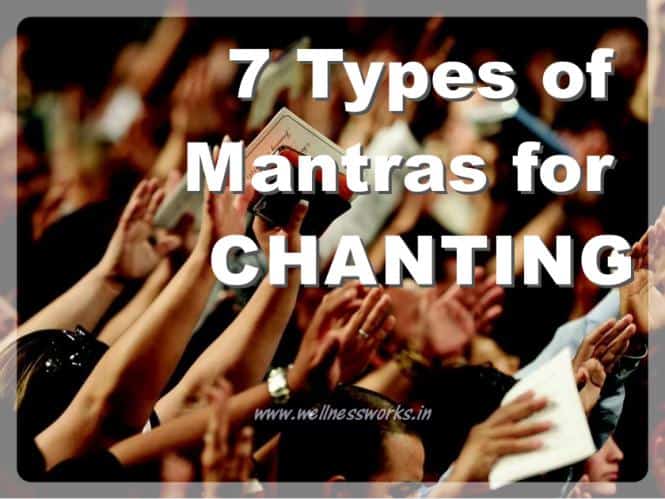The first thing that comes to your mind when you hear the word Meditation is – sitting with your legs folded and eyes closed, breathing in and out slowly and feeling a sense of calm. But did you know that meditation becomes a deeper experience if it is practised as a natural progression to Mantra Meditation Chanting?
In this article, we will understand in detail the answers to some most commonly asked questions regarding Mantra Chanting Meditation:
What is Mantra Chanting Meditation?
What is a good Mantra for Meditation?
What is your personal Mantra?
How to do Mantra Meditation by Chanting?
Most Effective Mantras used for Chanting
Before any of the above – let us get down to basics to know what is the meaning of Mantra.
What is a Mantra?
A Mantra is a syllable, word, sound, or phrase repeatedly chanted during meditation. Mantras can either be spoken, chanted, whispered, or repeated both in the mind or aloud.

What is Mantra Meditation?
Mantra Meditation is simply the process of calming and focusing the mind using a sound, phrase or word recited repeatedly either silently or aloud. It is an essential practice in many forms of yoga. It helps deepen your inner awareness and keeps you away from negative thoughts and energy.
Chanting Mantras is a ritual in almost all religions such as Hinduism, Buddhism, Sikhism, and Jainism. However, the reciting of sacred words is now part of many spiritual traditions such as Christians and Sufis.
Mantra meditation techniques always have two essential components: mindfulness meditation and mantra chanting.
How to do Mantra Meditation Chanting?
“Thoughts are just visitors, let them come and go.” – Anonymous
Mantra Chanting starts with discovering the mantra type suitable for you. Why do you select a Mantra and how is what you will find as you read further.
1. What is your Personal Mantra and Why?
The following are the two big questions we will understand before we start Mantra Meditation by Chanting.
Every person is looking for a different outcome to do meditation. Some of you may want to do mantra chanting for mental or physical health and wellbeing, whereas some of you may be looking for spiritual awakening. Once you know the reason why you want to practise mantra meditation – the path to choosing a suitable mantra for you will become easier.
- Mantra Chanting Meditation helps you both physically and mentally: it decreases anxiety and stress, cures depression, energises your body, cleanses your thoughts, helps you focus better.
- The spiritual benefits of mantra chanting meditation are aligning your vibration to create awareness, releasing emotion through self-expression and letting go.
Choosing the right mantra and repeating them continuously will help you disconnect from any negative thoughts that arise during meditation. It will also keep you focused on your intention. You could identify if you have a spiritual or a secular approach.
Take a few minutes to dedicate your practice to something and have clarity on your intention. This will help you to focus on and achieve a deep state of meditation and relaxation.
2. Find the Mantra for Chanting Meditation Suitable for your Intention:
Mantras are especially helpful to make you feel the vibrations they emit by chanting. The very same mantras are key to let you enter into a deep meditative state by bringing in positivity in your being. Therefore, when you repeat the mantras while chanting meditation – they stop you from thinking and whatever is the reason or intent of your meditation becomes more focused.
Here are some Powerful mantras you can Choose from with How they could BENEFIT you:
A. Om (Aum) Chanting Mantra
Aum or Om – the most powerful yet basic mantra you can chant is the sacred sound of Hinduism and its meaning is said to be – “The word of God.” It is believed to be the origin of all divine and other creations or forms of consciousness. This universal mantra creates a powerful and positive vibration in your lower abdomen.
You can chant Om or Aum as many times as you wish for your mantra meditation practice. Read our detailed blog on 3 Ways to Chant Om Properly
Follow 108 Om Chanting to practise:
B. Hare Krishna Mantra
“Hare Krishna” is also known as the Maha-Mantra to connect you with the Supreme Lord through chanting his holy name. By chanting this mantra you attain salvation and peace of mind. Moreover, it chanting or hearing the mantra will cleanse your mind and elevate your spirit and soul. Repeat the mantra as many times as you like.
Hare Krishna, Hare Krishna,
Krishna Krishna, Hare Hare,
Hare Rama, Hare Rama,
Rama Rama, Hare Hare!

C. Buddhist Mantra – Nam Myōhō Renge Kyō
Nam Myōhō Renge Kyō is a powerful mantra that captures the true essence of Buddhism. The purpose of this mantra gives you the ability to overcome any problem or difficulty that you may encounter in your life. It gives the capacity to transform any suffering into happiness.
The mantra comes from Sanskrit words that translate to “dedicate oneself to the universal and mystic law that permeates the eternal truth”.
Chanting this Buddhist mantra will reap the benefits of strength, enlightenment, luck, and happiness into your life. Chanting this mantra will help you overcome fears and change defeat into victory. You can chant this mantra as many times as you like.

D. Christian Mantra Meditation
The Christian Meditation or the practice of Contemplative Prayer is similar to mantra meditation in Christianity.
A famous phrase that is also a powerful affirmation – “I AM THAT I AM” was God’s answer to Moses when Moses asked for God’s name. It is said in the Bible in the Book of Exodus 3:14 (Chapter: Verse). This phrase was considered to be a very powerful tool in the practice of meditation. Listening or chanting the mantra will resonate and connect you to God that will help you live a fulfilled life. The same thoughts are projected by Dr. Wayne Dyer who uses this phrase in his meditation practice every day.
Another way of practising Christian Mantra Meditation is by choosing a sacred word from the Christian tradition. Such as, Lord, Father, Jesus, Mary, Abba, Mercy, Love, or Maranatha (which is Aramaic for “Come, Lord!”) and then chant with feelings of devotion.
This style of Christian Meditation was created by an Irish Benedictine monk John Main, who learned all about mantra meditation from a Hindu Swami in Malaysia.

E. GAYATRI MANTRA
The Gayatri Mantra is a universal prayer and a sacred chant that has been enshrined in the Vedas. It is addressed to the Immanent and Transcendent Divine.
Om Bhur Bhuvaḥ Swaḥ
Tat-savitur Vareñyaṃ
Bhargo Devasya Dhīmahi
Dhiyo Yonaḥ Prachodayāt
In simple words, it is a prayer to the Divine Mother asking her to take away all the darkness that resides in our hearts and fill it with her illuminating light. Chanting Gayatri mantra has positive effects that help in increasing your concentration and learning power. It also strengthens the mind and improves the rhythmic pattern of breathing.

F. Ho’oponopono Mantra Meditation
Ho’oponopono is an ancient Hawaiian practise for healing oneself. The word Ho’oponopono means to correct relationship problems and heal yourself.
In this practice, you clean yourself from your own negative feelings that are embedded in your memory or consciousness. Through this chant and practice, you are affirming the thought within yourself that you no longer want to associate or suffer from these negative thoughts.
The mantra is 4 simple phrases you might use every day but do not realize how powerful they are when said with an intention.
I AM SORRY
PLEASE FORGIVE ME
THANK YOU
I LOVE YOU
When using this mantra, you are speaking to the Divine or your Creator directly with the aim to heal yourself, ask for forgiveness, allow to love yourself and express gratitude for everything that you have. Chanting this mantra in your meditation practice will help you heal your soul and mind. Even, if you have trouble sleeping listen to this mantra or repeatedly chant it, you will automatically fall asleep.

G. Secular approach
In this meditation practice, you don’t necessarily have a spiritual belief. You practice this kind of mantra meditation for good health, personal growth or peace, and relaxation. Even if you are spiritual in nature but want to keep your meditation practise separate from that, then this meditation practice is for you.
First things first, you can choose a word or a short sentence as your mantra that has a valuable meaning and message that you want to imbibe in your mind.
When choosing your mantra, keep the following in mind:
- The meaning of your mantra is very important. Choose a word or sentence that you want to connect with or that you want to become. For example, words such as love, peace, freedom, awareness, light, courage, and so on.
- The sound of the words need to speak to you. Thus, keep repeating the word for a few minutes and see how it makes you feel before and after chanting it.
- Avoid words that have uncertain meanings or negative connotations.
- Try a few mantras before you start your meditation practice.

How to do Mantra Meditation Chanting continued…
3. Find a comfortable place to practice Chanting
To practice mantra meditation, find a quiet, comfortable and a dim-lit place either at home, a yoga studio, an empty hall or in a not so crowded park.
It is best to practice in a place that is solitary, calming ambience. Avoid being disturbed from electronics like notifications from your mobile, TV Screen, or doorbell. Moreover, in case you want to be in solitude and want to shut the windows or door to reduce distractions – it is absolutely fine.
Tip: For those of you who have kids at home, choose a time when they are asleep or away to school to avoid distractions.
Creating The Mood:
You can light incense or candles, play soft music to soothe your nerves or use dim lights to get you in the right mood. For each of you, it may be different. Some of you may prefer to sit out on your backyards facing the sun rays as you chant. Or, some of you may prefer to do mantra meditation chanting in a sacred place or temple.

4. Sit in a comfortable posture
To start mantra meditation, sit in a cross-legged position with your head and back straight. Eyes either looking straight ahead at a fixed spot or eyes could be closed focusing on the imaginary spot between your eyebrows.
TIP: In case you have difficulty in sitting cross-legged on the floor, sit on a chair or sofa with your back against a wall or cushions propped.
Always, keep your spine and back erect to obtain and absorb the mantra’s vibrations. You can even take a light blanket if you feel cold. Most Importantly, make comfort your priority. Place your hands lightly on your knees in Gyan or Chin Mudra. For some of you who prefer – feel free to use prayer beads so that you don’t have to count the number of mantras and can focus better.
Place your hands lightly on your knees or if you like in Chin or Gyan Mudra. Also, you could use prayer beads to concentrate diligently and enter into a deep meditative state.

5. Focus and Feel your breath
Your breath should be long, deep and relaxed before you start any kind of chanting. Mantra Meditation is incomplete if you do not get your breath in order. Never force your breath. Let it be a natural deep inhalation followed by a long exhalation for 5-6 times to change the rhythm of your breath.
Bring your awareness to the breath on your upper lip and expand your chest and abdomen as you inhale and gently push your abdomen towards your spine as you exhale. Feel every part of your body soaking int he fresh oxygen and positive energy you are sending to yourself with every inhalation.
Focus more on your mantra as the breathing tends to naturally synchronize with the rhythm of the mantra with time.

6. Chanting your chosen mantra
There is no hard and fast way on how many times to chant a mantra. Don’t think longer mantras will have a deeper effect.
The repetition of your mantra should be gentle and relaxed, do not force it. If you are starting with OM or AUM chanting, you will feel the vibrations in your brain and lower abdomen first. If you can’t feel this vibration, then you need to correct your posture. Lengthen your spine for the vibrations to flow right through.
Do not be embarrassed if you are not pronouncing the mantra the right way as it may have different pronunciations. Continue to pronounce what you think is best. You can always ask someone later for the right pronunciation.
Do watch our Video on 108 times Om Chanting Guided Meditation by clicking here.
Concentrating on perfecting the mantra might make you lose your intention or reason for practising meditation.
For short mantras – say it once while inhaling and then chant again while exhaling. You can also increase the speed of your mantra and repeat it 3 times on inhalation and 3 times on exhalation.
For long mantras – chant half of the mantra on inhalation and the second half on exhalation.

7. Mantra Chanting – Aloud or Silently – the Choice is Yours
Both loud and Silent Mantra Meditation by chanting is beneficial.
Chanting any mantra aloud will energize you, whereas chanting slowly or silently will calm your mind. It depends on how you are feeling. Take a cue from your instincts – how do you feel comfortable. What does your body say to you? Tune in! Listen to your inner voice and follow it.
For beginners- it is advisable to chant aloud so that they can focus better.
No matter how you meditate, let your body flow in that rhythmic sound and moment.
“Repeating your mantra fast produces gamma waves in the brain. Repeating it slowly produces theta waves.”
There will be times when you want to chant for less time and meditate silently for a longer time, then allow your mind and body to follow it. Do not force it.
8. Duration of Mantra Chanting
For beginners it is best you start chanting for 5-10 minutes. Once you become comfortable with your mantra chanting routine – you will start looking forward to it. You should increase the duration to 20-30 minutes a day. Soon you will realise how better you could concentrate the day you chanted. Trust me, I speak with years and years of experience in chanting.
You could transit to silent meditation after 20-30 minutes of mantra chanting. Continue sitting in the same position with your eyes closed and meditate for as long as you want to. This will allow you to focus on your reason, purpose, and intention and help you achieve relaxation at a maximal level.
- Try and keep your attention towards your breath and vibrations. The energy and vibrations in your body will linger much after you stop chanting.
- It is natural for your mind to wander. Each time your thoughts go astray – be gentle with yourself. Let go of the thoughts both related to past and future – these may be the reason for your un-ease, worry, restlessness. They may also not let you soak in the positive vibrations emitted by chanting mantras. Thus – the trick is to focus on the NOW – the present moment. Keeping past and future aside.
- Exhale and let out all the unwanted uncomfortable thoughts in your mind. Say to yourself anything unwanted is returning to its source – but in the form of love and light!
- As you inhale soak in all the goodness, the abundance of positivity all around you and bring then inside you. Yes, it will need lots of patience and perseverance. Moreover, once you realise how much you will benefit from each Mantra Chanting session it will become like an addiction for you.
- Chanting Mantra Meditation – teaches you to forgive, to be thankful, to be compassionate, to accept, and heal yourself.

Bottom Line
Mantra Meditation is effective as long as you follow the basic guidelines. The key is to choose the right mantra as per your intention and purpose. Practice this meditation diligently and you will change the course of your life internally and externally. Sit in the right posture that you are comfortable in and breathe the right way while chanting your mantra. If you do not have an intention to start with, choose a word that you connect with and begin your meditation practice.
Related Articles:
How to Turn negative thoughts into Positive Thoughts
8 Ways to attract good energy in your life every day
Psychologists Find that Cooking is Meditation
Meditation Benefits- 5 Medically proven Gains
How to sit in Meditation – Cross Legged or on a Chair
Negative Thoughts – deal and turn them into Positive Thoughts
Guided 108 Times – Om Chanting Meditation
5 Tips to Practice Yoga while Travelling – making it Irresistible








